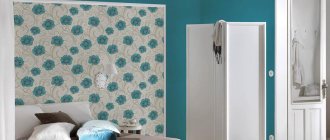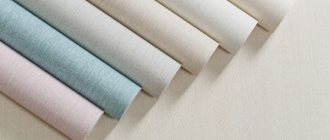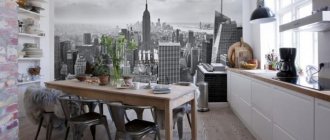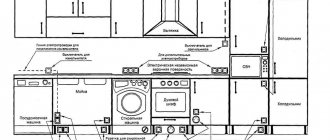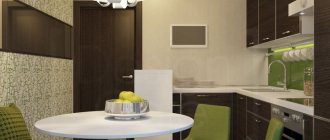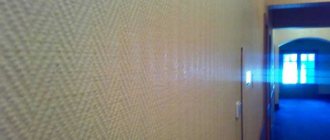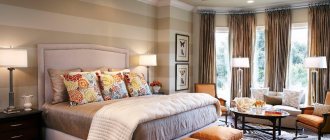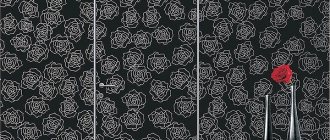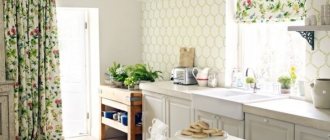During repairs, situations may arise that are difficult for an inexperienced person to cope with without prompting. For example, if you lay tiles on a kitchen backsplash, and you have to glue wallpaper above or on the side, then the places where they join may not have a completely aesthetic appearance if you don’t know the specifics.
In this case, some people tear out the wall to create a uniform plane of tiles with wallpaper pasted. But you can use other methods to hide this unsightly area.
How to match wallpaper with tiles on a kitchen apron
During repairs, situations may arise that are difficult for an inexperienced person to cope with without prompting. For example, if you lay tiles on a kitchen backsplash, and you have to glue wallpaper above or on the side, then the places where they join may not have a completely aesthetic appearance if you don’t know the specifics.
In this case, some people tear out the wall to create a uniform plane of tiles with wallpaper pasted. But you can use other methods to hide this unsightly area.
The role of wallpaper tiles in surface decoration
In appearance, imitation tiles are not inferior to wallpaper. Tile manufacturers annually offer collections that contain several stylistic solutions in the form of tiles to match the wallpaper. It can be anything:
- One or more colors;
- With or without a pattern, ornament;
- With or without a picture;
- Large, medium or small;
- Glossy, matte, polished, etc.
Tiles that imitate wallpaper retain their appearance throughout the entire period of operation. The design and color do not fade or fade - all the same rich and bright shades. Tiles with a matte surface prevent glare, although the glossy version looks no less luxurious.
Preliminary stages
When choosing the appropriate method, you should determine the thickness of the tile, and also calculate what the thickness of the adhesive layer underneath will be. If the walls were not previously leveled to zero, and the tiles on the kitchen apron were laid on a pre-applied layer of glue, you should allow time for it to dry completely. This should be done because during drying, the thickness of the adhesive mixture decreases.
At the next stage, grouting of the tile joints is carried out. After the specified drying time for the adhesion agent has passed, the tile should be wiped with a damp sponge, removing excess grout, as well as traces of the mixture, which usually stains the surface of the tile. The resulting dust must be brushed off the top row (end) of the tile. Then the end part is primed and time is given for the mixture to dry.
Sealant
This tool is suitable for eliminating a joint if the edges of two materials fit perfectly together and their texture is similar. In such a situation, you can make the joining line invisible using a sealant of a suitable color or a transparent composition.
Important! The sealant is best suited for combining tiles, mosaics, porcelain tiles, and panels.
Sealing the joint with sealant
It can be used even in damp rooms. True, it will have to be replaced periodically, since the service life of the material is only 2-3 years.
Gluing
Having secured the baseboard under the ceiling, you can begin gluing wallpaper. Gluing is carried out starting from the top of the wall, from the baguette.
The part that will be adjacent to the tile is turned onto its end. The excess fabric is carefully trimmed with a stationery or special knife with a retractable, replaceable blade. The cut is made at the fold. With a small layer of glue, the cut can be made directly along the tile line.
Is it possible to apply liquid wallpaper to tiles?
Applying liquid wallpaper to tiles To apply silk plaster to tiles, you first need to clean the surface of dirt, remove damaged or loose tiles and dry the cleaned area. After this, you can begin priming the surface, for example, using Concrete Contact.
Interesting materials:
Where are children's cards accepted in St. Petersburg? Where is Ancient Greece located on the map? Where to unlock the troika card? Where to withdraw cash from a Post Bank card? Where to collect all the cards for Gwent The Witcher 3? Where can I find out why my social card was blocked? Where are the coordinates in Yandex maps? Where to insert a SIM card into iPad? Where can I win cards for Gwent? Where can I get the Witcher 3 Geralt card?
Curbs
It is possible to brighten up the junction of the kitchen apron with other details:
- special tiled border;
- decorative frieze.
In this case, cutting of the canvases is carried out directly along the frieze or along the edge of the border.
Wallpaper can also be placed under the tiles. Therefore, you can not lay the outer row of tiles, but insert the cut edge by 8 mm, and then lay out the last row of tiles without first filling the upper part with the adhesive mixture. In this case, the adhesive is applied to individual tiles rather than to the wall itself using a notched trowel.
Important! Using borders is not the best way to connect tiles to wallpaper, as this can stain their surface with glue. Also, the end part may have errors.
Experienced craftsmen install external corners. It should be borne in mind that both horizontal and vertical elements located in the end part are used.
When choosing a suitable method of combining two types of finishing materials, you should take into account not only the aesthetic aspect, but also the practical possibility of carrying out such work.
Laying tiles
It all depends on the design you have in mind and the size of the tile. However, there are several styling methods that have proven themselves over time.
- The traditional method is when the tiles are laid in even rows, forming a single grid, regardless of size.
- With offset. The tiles are laid diagonally, moving sideways with each new piece.
- Diagonally. This means that the construction of the pieces comes from the corner. Square tiles are best suited for this method.
Features of kitchen finishing with tiles and wallpaper
The kitchen is the most beloved and cozy place in the house, so it is important to think through the interior style as much as possible and choose the right combination of colors and textures. Finishing the kitchen with tiles and wallpaper is the central link in the design. It is not enough to just carefully stick the materials on; it is important to select and combine them. Kitchen interiors can be bright or decorated in subdued colors.
In addition to being visually impressive, materials must be practical, resistant to moisture and high temperatures.
Choosing a finish
Despite the wide range of materials for finishing kitchens, traditional tiles and wallpaper still occupy the leading positions.
The main qualities that people pay attention to when choosing wall coverings are non-staining, resistance to steam and heat, and harmonious design. A wide selection of wallpapers is offered.
- On paper. This is a very inexpensive segment, available in a variety of colors and patterns. This type is not recommended for the kitchen; it cannot be cleaned. However, it is possible to use them in combination with more durable materials when decorating the dining area.
- On a non-woven basis. This is a more serious version of paper wallpaper, which, in addition to cellulose, also contains polymer. They are good for painting, their structure is unusual. Gluing them is very simple, they allow air to pass through, are dense and easy to clean. An undeniable advantage is the ability to repaint if you are tired of the design.
- Vinyl. The most common type, their base can be either paper or vinyl-coated non-woven fabric. They perfectly hide wall defects, are durable, easy to maintain, and withstand mechanical damage. They provide great design opportunities, as they imitate wood, stone, and brick. The downside is that they do not allow air to pass through, so antifungal treatment is recommended in very damp rooms.
Epoxy grout
Another option for a neat joint can be made using epoxy grout. This method is recommended for use on walled and ceramic-tiled countertops. Some owners of such sets prefer cement grout, and make a serious mistake. Despite the fact that epoxy is much more expensive than regular grout, it is more practical in the kitchen, because it has zero water absorption. Simply put, it will not collapse from contact with a humid environment, fungus will not grow in it, and it will not change its color. Externally, this option looks very fresh and clean.
Combination of materials
Most often in modern housing, the kitchen combines both working and dining areas, so its functionality is expanded. The correct combination of materials will allow you to take into account the characteristics of each zone and distribute them adequately to the load. A workspace that is exposed to dirt, high humidity and heat is ideally decorated with tiles. This is a sink, a hob. The rest of the room can be safely decorated with wallpaper; it’s cheaper, more interesting from a design point of view, more comfortable, and leaves room for interior experiments. The use of additional elements in the decor looks great: glass panels, decorative plaster, photographs on various surfaces, wood trim.
How to properly arrange joints?
Methods for laying tiles depend on the size and shape of the selected material and the presence of decor. Experts distinguish between three main methods:
- diagonal, that is, the direction of the laying goes from one corner to another, suitable only for square tiles;
- the staggered or offset method is essentially similar to bricklaying, in which the material of subsequent rows is laid so that its center falls on the seam of the bottom row;
- traditional, in this case, tiles of any shape and size are laid out in an even row, the seams forming a regular grid.
These methods are used both when laying out walls and floors. Ideally, the tiles for both surfaces should match in style and color, and be from the same collection. If you decide to combine materials from different manufacturers, be sure to include a certain amount of reserve when purchasing, which will be used for errors during cutting and fitting.
There are three ways to create an aesthetic, invisible transition between materials:
- using grout, rounding inwards, after drying the joint is sanded, the wallpaper is glued overlapping;
- decorate the joint with grout in a convex manner, paint it to match the color of the wallpaper;
- use metal or wood overlays if the chosen design allows it.
Sealing a joint without a threshold
If there is no possibility or desire to use the threshold, you can use other available methods.
Inter-joint grout
The use of grout is well suited for situations where the installation of the floor covering is completely completed. It will not be possible to apply grout where there is a height difference between the materials. In this case, it will not hide all the defects and will quickly crumble.
The gap between the laminate and the tiles is sealed with high-quality cement or epoxy grout. The order of work will be as follows:
- mark the line of the future seam on the floor;
- without going beyond the line, lay the tiles;
- install the laminate, having previously treated its edge with silicone sealant;
- allow the coating to dry;
- cover the seam with grout;
- Level the grout and, after drying, coat it with varnish.
Cork compensator
An expansion joint is a thin strip of cork that is inserted into the gap between floor materials. Suitable for joints of any shape and size, but the height of the coatings must be the same. If the part is not long enough, several compensators are used. They are also covered with transparent varnish or painted on top, decorated with veneer.
Cork sill compensator
Cork sealant
This composition contains fine cork chips. Once applied, it creates a joint that looks like natural wood. Working with cork sealant is very simple. It must be squeezed out of the tube, carefully fill the joint, and smooth it out with a narrow spatula. Excess sealant from the edges must be removed immediately. There is no need to treat the edge of the laminate before sealing - the cork composition will cope with this task.
Beautiful examples
The brighter the tiles, the sharper the contrast, the calmer and more laconic the walls should be. By following this simple rule, you can avoid a too flashy and intrusive interior, even using very bright tiles to decorate your work area.
To fit such a combination, it is enough to dilute it with a third neutral shade, for example, white, and use it as the main color of the wallpaper.
An incredibly positive combination of shades of yellow and blue looks great against a snow-white background.
The yellow-blue composition will serve as an excellent backdrop for blue accents and neutral-colored wallpaper.
This color scheme will look especially advantageous in a patterned version on a muted gray-blue background.
Metallic profile
Another good way to connect a table and an apron in the kitchen involves using a so-called folding tile corner. Two types are popular - plastic and metal. The first one looks frankly cheap, so interior designers suggest choosing the second option. With the help of a metal profile, you can reliably and accurately mask the gap between the wall and the countertop, without using any putties or sealants. In order for this element to look appropriate and harmoniously combine with the set as a whole, it is better to select the color of the profile to match the shade of the faucets, roof rails or even the sink.
Any of the options proposed above will help bring your kitchen to life and finally finish the renovation work.
How to make a joint between tiles and wallpaper
Walls play a significant role in interior design, so you need to approach the choice of wall decor with the utmost seriousness. Our store offers more than a thousand varieties of wallpaper: paper, vinyl, non-woven, flock, textile, cork, velor, silk, fiberglass, photo wallpaper and panels, bamboo panels, reed and rattan fabrics in various price segments: premium, medium and economy.
In addition, you can purchase sconces, lamps made from natural materials, chandeliers, table lamps, spotlights, children's lamps, floor lamps, etc. If you prefer products from European countries, we offer high-quality products made in Germany, Italy, Belgium, France, The Netherlands, which combine excellent strength with beauty, sophistication, and environmental safety.
Check out the huge selection of wall decor from famous brands, enjoy affordable prices, or simply find what you need.
Take your time to purchase wallpaper in construction hypermarkets. It is much more convenient and cheaper to buy wall coverings in the specialized online store LustorMarket. The cost of rolls depends on the quality of the finishing material, design, and characteristics. Our promotional offers and sales will help you save on decor. We constantly update our collections of wall coverings, and the store offers good discounts on decor from old collections.
To ensure that wall decor meets your expectations and repairs become a less expensive undertaking, we advise you to select products according to thematic headings, depending on your personal needs and preferences. This will help you purchase the product, taking into account its features and advantages. After all, it is you who have to make a choice and decide in favor of a specific expensive sample or give preference to a more inexpensive type of canvas. The main thing is that all types of decor will help you quickly change the style of the room’s interior, update the decor, and make your home cozy and comfortable.
Today it is difficult to find a house that is illuminated solely by natural light. Artificial or decorative light is an element that no interior can do without. Visit the virtual pages of our catalog and choose a lighting idea for your home. Images of light and their diversity are revealed in all its forms, which attract and make you admire.
Each buyer will be able to choose the ideal option, taking into account their financial capabilities and taste preferences. From us you can order such interior lighting as sconces, lamps made from natural materials, chandeliers, table lamps, spots, children's lamps, floor lamps, etc. We also offer a large selection of street lamps: recessed, wall and floor, for installation on a pole, etc. .
Our store offers more than 1000 varieties of wallpaper: paper, vinyl, non-woven, velor, flock, textile, cork, silk, fiberglass, photo wallpaper, bamboo panels, cane and rattan fabrics. Using any of these finishing materials, you can create a stylish, harmonious and beautiful environment in your room.
It is important to us that every customer has the opportunity to use truly good coatings and lighting fixtures. Therefore, we have set affordable prices for the entire range. You can buy all the required finishing materials at once and install high-quality lighting in your apartment or in your house and yard. We will do everything to ensure that you are satisfied. You can pay for your purchase in any way convenient for you. We deliver orders quickly and throughout Russia.
Contact our online store and you will have the opportunity to create special comfort and elegance in the living room, bedroom, children's room, hallway, kitchen, bathroom and any other room in your home. We can also find suitable solutions for office space. We look forward to your call so we can offer you truly unique wall finishes and quality lighting!
The assortment of our store includes the following types of wallpaper.
Do-it-yourself finishing materials for simulating a brick wall
To create an imitation brick wall with your own hands, use the following materials:
- wallpaper;
- tile;
- plaster;
- fake diamond;
- brick panels;
- plasterboard panels.
A few words about each of the options.
Imitation brick wallpaper
This is the simplest way to depict imitation brick with wallpaper. The textured surface allows you to get the appearance and tactile structure closest to the original.
Wallpaper in the hallway
This method does not replace brickwork, but it has its own advantages:
- budget;
- speed of registration;
- ease of care (dust can be removed by washing if non-woven wallpaper is used).
Pay attention to the special wallpaper made from foamed polymers. Thanks to them you will create the most realistic texture.
Brick wallpaper in the kitchen
From plaster
To make an imitation of a brick wall with your own hands using plaster, first plaster the wall. Smooth the applied solution with your hands. As soon as the plaster hardens, the contours of the brick appear on it. When drawing, you can use a ruler, but the bricks look more realistic if you draw them by hand.
How to make imitation brickwork using plaster
The plaster is removed along the drawn lines, and the contours of the bricks are formed. The grooves are covered with a brush. This way, unnecessary plaster crumbs and other debris are removed from them.
Decorative rock
Artificial stone is distinguished by high levels of stability. Eco-friendly, there are product quality certificates at points of sale. The price depends on the quality. It is widely used due to its availability, large number of textures and aesthetic appeal.
Brick panels
Advantages of brick panels:
- Affordable price;
- Light weight;
- Possibility to install yourself;
- Huge selection of colors;
- Easy to care for;.
- Ideal combination with any materials.
Imitation brick with PVC panels Imitation brickwork from panels is attached with your own hands to plaster, concrete and old brickwork. The reason for this “flexibility” lies in the production secret - UV stabilizers, which give the raw materials strength and protect them from damage and scratches.
The panels are distinguished by a wide range of colors and textures . They tolerate high humidity and the influence of cleaning agents, which makes it possible to use brick-like panels for interior decoration of toilets, kitchens and corridors.
Fixation to the wall is carried out with glue or on the lathing.
Tile
An easy option, based on clinker or ceramic tiles. It is glued to the prepared wall surface, and the gaps between the parts of the tile are covered with plaster or a special mixture.
Made from materials:
- clinker brick;
- tree;
- gypsum;
- Styrofoam.
Such tiles are made of polystyrene foam, gypsum and wood.
| Photo | Name | Description |
| Clinker | Clinker tiles are made from ceramics. It is made from special types of clay into which coloring substances are mixed. In order to imitate brick with tiles in the required shape, the pressing method is used. | |
| Ceramic | Ceramic tiles differ in manufacturing methods: cutting, pressing, extruding. A large assortment of textures and colors allows us to reach consensus in the design of the room. |
From plasterboard
For production, the required number of tiles are laid on a cement adhesive mixture. Wooden slats are used to form the seams. Long planks are placed in horizontal openings, and tiles are placed on the narrow side in vertical openings so that their lengths and the dimensions of the seams match.
From plasterboard
After laying the row, the slats need to be removed, and the seams are filled with a special compound or a special mixture for filling the gaps between the tiles. The wall is painted by hand and varnished if desired.
Painting
From foam plastic
An unusual but interesting solution is foam bricks. The material is lightweight, with low thermal conductivity and high sound insulation. Cut the foam into bricks of any size and texture of your choice. The resulting tiles are primed and painted.
Imitation foam
Polystyrene foam is fragile, so you shouldn’t expect a long-lasting effect from such decoration. Repairing the “masonry” is simple: foam chips are mixed with glue, after which the damaged area is filled with a spatula. If the area is large, cut it out from the wall and glue in a new one.
Joints on different types of wallpaper
Depending on the type of wallpaper, the joints look and connect differently.
Paper
The paper stretches under the influence of the glue, and when it dries it returns to its previous size. This is a common cause of uneven reduction of panels and the appearance of tears and flaws at the joints. To avoid this, you need to glue the wallpaper to the wall immediately after applying the glue, before it swells.
Vinyl
Difficulties in this case arise when connecting the strips in the corners. The reason for this may be the unevenness of the walls and their insufficient preparation. Cutting the joint through will help. The wallpaper is pasted in the corner with an overlap of 3 cm. Then this place is cut through, creating a butt joint between two strips. The joint area is coated with glue and smoothed.
This gluing method is required for paper wallpaper.
To prevent joints from appearing on vinyl wallpaper, you need to glue the strips into a cape. For wallpaper with a non-woven base, an overlap of 2 cm is enough, with a paper base - 4 cm. After this, the joint is cut with a knife according to the level, and all excess is removed.
The cause of defects may be the wrong choice of glue, before using which you need to carefully read the instructions.
For wallpaper with a non-woven base, you need appropriate glue, which is used to smear the wall and wallpaper. The paper base involves applying it only to the wallpaper itself.
Non-woven
This type of wallpaper does not have any particular difficulties with the divergence of joints, since they do not stretch like paper. The main attention should be paid to the corners, which are covered with an overlap and then remove all excess. When gluing the outer corners, simply joining the strips is enough. If the angle is uneven, you will have to glue the sheets overlapping again.
Skirting board from the manufacturer
Probably the simplest of all possible methods is to close the joint between the table and the wall with a special small plinth suitable for the tabletop. What's good about this option? Perhaps, because you won’t have to rack your brains about choosing the right material, correct installation of the plinth, etc. All you need is just to order a complete plinth part from the manufacturer of your set. The nuance of this option is that the surface under the kitchen apron must be perfectly flat so that the baseboard fits as tightly as possible.
What to consider before starting work
Before wallpapering, you need to carefully prepare the wall. If there are irregularities on it, then imperfections at the joints of the canvases are inevitable. The wall must be puttied, sanded and primed.
Without a primer, there is a lot of dust on the wall, which absorbs the glue and prevents a good connection with the wallpaper. It is preferable to apply the solution one day before the planned work.
To prevent problems with wallpaper joints, you should apply the glue correctly. Its excess or deficiency leads to unpleasant consequences. If the glue layer is too thick, it will take a long time to dry.
If glue is applied to wallpaper, then you should fold the strip into an envelope and run over it with a rubber roller to distribute it evenly. The procedure must be repeated after placing the wallpaper on the wall.
When purchasing, it is best to pay attention to wallpapers with a large width. This way there will be fewer joints, and it will be possible to disguise them with furniture and accessories.
Lighting and furniture
Often, well-chosen lighting allows you to visually mask the difference in planes. For example, when the perimeter is illuminated from the inside, a volumetric panel will successfully merge with the surrounding surfaces, and the junction of materials will become natural and logical.
In addition, the border of different textured finishes can be successfully hidden with furniture. The easiest way is to hang shelves and install an interesting rack. When connecting vertically, you can install a built-in cabinet in the problem area.
How to effectively hide the joints between wallpaper
Most often, the following problems arise with joints:
- The divergence of the canvases, which causes a gap to appear between them. This problem can be eliminated by painting the wallpaper. A more budget-friendly method would be to use tile grout in the joint area, to which a suitable color is added. You can fill in the gap with a marker or pencil. A more complicated method is to add crumbs removed from the wallpaper to PVA glue and apply this solution to the crack. If the wallpaper has come apart slightly, you can soak the edges of the strips with warm water and try to pull them together.
If the gap between the wallpaper joints is wide, it is sealed with special decorative strips - Glue gets on the front side of the wallpaper. Before drying, you can wipe it with a clean white cloth or napkin. On paper wallpaper, this should be done carefully, simply blotting the area. On dark panels, traces of glue are well masked with a retouching pencil.
The procedure is performed carefully and slowly - Curling and lifting the edge of the wallpaper. This drawback can be easily eliminated with wallpaper glue. The edges of the strips are put back in place; for reliability, it is better to roll the seams with a rubber roller.
The rubber roller not only smoothes the wallpaper when gluing, but also carefully removes excess glue and air bubbles
